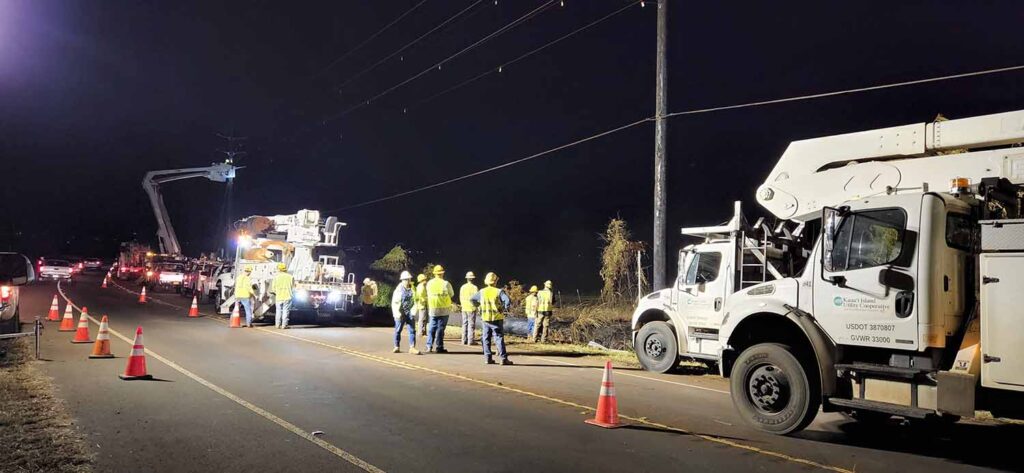
Kauaʻi Island Utility Cooperative tapped into the strength of small island cooperation to keep electricity flowing to as many of its consumer-members as possible when a wildfire consumed more than 1,100 acres and threatened 200 homes in its territory earlier this summer.
The brief crisis began around noon on July 15, when a brush fire broke out near Hanapēpē and quickly grew into a wind-stoked wildfire that spread east toward the small town of Kaumakani.

Officers from the Kauaʻi Police Department went door-to-door to evacuate more than 200 homes in Kaumakani, and residents fled to a school and community center that were turned into shelters by local authorities, according to a news release from the Kauaʻi Fire Department.
While brush fires are relatively common on Kauaʻi, evacuations of residential neighborhoods have rarely been necessary, said Beth Amaro, KIUC’s manager of member services and communications.
Police asked the Līhuʻe-based co-op to de-energize transmission lines between Hanapēpē and Kaumakani about three hours after the fire began to help keep firefighters safe and avoid sparking new fires. To do so, KIUC had to de-energize its transmission lines for all 2,500 members west of Hanapēpē.
The circuits feeding roughly 350 members in the fire-threatened areas of Hanapēpē, Kaumakani and Pakala were successfully de-energized. However, power continued to flow to members in Waimea, Kekaha, Mānā and Kōkeʻe using solar and battery resources from the U.S. Navy’s Pacific Missile Range Facility in west Kauaʻi. This facility, which has a 14-megawatt solar field paired with a 70-megawatt-hour battery energy storage system, is owned and operated by AES, a global energy company.
Keeping power on in Waimea was important to ensure that there was electricity for Kauaʻi Veterans Memorial Hospital and for an emergency shelter for people who had to evacuate their homes, Amaro said.

At about 6:30 p.m. on the day of the fire, KIUC proactively de-energized its lines to about 1,100 members in Kekaha, Mānā and Kōkeʻe to preserve stored energy for the crucial facilities in Waimea.
By creating its own microgrid with the help of the AES PMRF facility, KIUC could continue to get power to most of its members in the midst of the wildfire, she said.
“That was a really exciting takeaway for us,” Amaro said. “It was an important lesson to see how these assets could be used as microgrids when we do get into these situations.”
Fortunately, firefighters were able to contain the wildfire by around midnight by using helicopters to drop water on the flames and heavy machinery to create fire breaks, according to news reports. Only one shed was destroyed by the flames, and Kaumakani residents were able to return to their homes the next day.
By 3 a.m. on July 16—the day after the fire broke out—the co-op had replaced four damaged transmission poles and restored power to all its members. KIUC suffered about $150,000 in damage to its system, Amaro said.
The story is a tribute to collaboration, she said.
“When you live on a small island, everyone knows each other and we’re used to working together,” she said. “We had very severe flooding in April 2018 and we had a big hurricane hit us in 1992. We know we have to be self-sufficient here because it’s almost impossible for anyone off the island to send us support immediately. We get through these disasters by working together.”
Erin Kelly is a staff writer for NRECA.